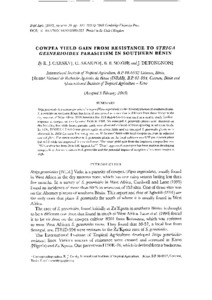| dc.contributor.author | Gong, Y. |
| dc.contributor.author | Egal, S. |
| dc.contributor.author | Hounsa, A. |
| dc.contributor.author | Turner, P.C. |
| dc.contributor.author | Hall, A.J. |
| dc.contributor.author | Cardwell, K.F. |
| dc.contributor.author | Wild, C.P. |
| dc.date.accessioned | 2019-12-04T11:23:54Z |
| dc.date.available | 2019-12-04T11:23:54Z |
| dc.date.issued | 2003 |
| dc.identifier.citation | Gong, Y., Egal, S., Hounsa, A., Turner, P.C., Hall, A.J., Cardwell, K.F. & Wild, C.P. (2003). Determinants of aflatoxin exposure in young children from Benin and Togo, West Africa: the critical role of weaning. International Journal of Epidemiology, 32(4), 556-562. |
| dc.identifier.uri | https://hdl.handle.net/20.500.12478/4201 |
| dc.description.abstract | Background Dietary exposure to high levels of the fungal toxin, aflatoxin, occurs in West Africa, where long-term crop storage facilitates fungal growth. Methods We conducted a cross-sectional study in Benin and Togo to investigate aflatoxin exposure in children around the time of weaning and correlated these data with food consumption, socioeconomic status, agro-ecological zone of residence, and anthropometric measures. Blood samples from 479 children (age 9 months to 5 years) from 16 villages in four agro-ecological zones were assayed for aflatoxin-albumin adducts (AF-alb) as a measure of recent past (2–3 months) exposure. Results Aflatoxin-albumin adducts were detected in 475/479 (99%) children (geometric mean 32.8 pg/mg, 95% CI: 25.3–42.5). Adduct levels varied markedly across agro-ecological zones with mean levels being approximately four times higher in the central than in the northern region. The AF-alb level increased with age up to 3 years, and within the 1–3 year age group was significantly (P = 0.0001) related to weaning status; weaned children had approximately twofold higher mean AF-alb adduct levels (38 pg AF-lysine equivalents per mg of albumin [pg/mg]) than those receiving a mixture of breast milk and solid foods after adjustment for age, sex, agro-ecological zone, and socioeconomic status. A higher frequency of maize consumption, but not groundnut consumption, by the child in the preceding week was correlated with higher AF-alb adduct level. We previously reported that the prevalence of stunted growth (height for age Z-score HAZ) and being underweight (weight for age Z-score WAZ) were 33% and 29% respectively by World Health Organziation criteria. Children in these two categories had 30–40% higher mean AF-alb levels than the remainder of the children and strong dose– response relationships were observed between AF-alb levels and the extent of stunting and being underweight. Conclusions Exposure to this common toxic contaminant of West African food increases markedly following weaning and exposure early in life is associated with reduced growth. These observations reinforce the need for aflatoxin exposure intervention strategies within high-risk countries, possibly targeted specifically at foods used in the post-weaning period. |
| dc.description.sponsorship | Deutsche Gesellschaft für Internationale Zusammenarbeit |
| dc.language.iso | en |
| dc.subject | Aflatoxins |
| dc.subject | Dietary Exposure |
| dc.subject | Biomarkers |
| dc.subject | Child Growth |
| dc.subject | Weaning |
| dc.title | Determinants of aflatoxin exposure in young children from Benin and Togo, West Africa: the critical role of weaning |
| dc.type | Journal Article |
| dc.type | Journal Article |
| dc.description.version | Peer Review |
| cg.contributor.affiliation | University of Leeds |
| cg.contributor.affiliation | International Institute of Tropical Agriculture |
| cg.contributor.affiliation | London School of Hygiene and Tropical Medicine |
| cg.coverage.region | Africa |
| cg.coverage.region | West Africa |
| cg.coverage.country | Benin |
| cg.coverage.country | Togo |
| cg.isijournal | ISI Journal |
| cg.authorship.types | CGIAR and advanced research institute |
| cg.iitasubject | Aflatoxin |
| cg.accessibilitystatus | Limited Access |
| local.dspaceid | 99767 |
| cg.identifier.doi | https://doi.org/10.1093/ije/dyg109 |

